What are Azure Dedicated Hosts?
Azure Dedicated Host provides physical servers that host one or more Azure virtual machines of your choice. Azure Dedicated Host is a new Azure service that enables you to run your organization’s Linux and Windows virtual machines on single-tenant physical servers. Usually, if you run a VM on Azure Infrastructure, it can be hosted on a common host shared by other companies’ VM also, whereas Azure Dedicated Host service offers separate physical hosts, and you can manage the host only. Azure Dedicated Hosts provides visibility and control to help address corporate compliance and regulatory requirements. Azure Dedicated Host service extends Azure Hybrid Benefit to Azure Dedicated Hosts, so you can save money by using on-premises Windows Server and SQL Server licenses with Software Assurance or qualifying subscription licenses when you use Azure VMs on your dedicated host.
Table of Contents
- What are Azure Dedicated Hosts?
- Creating an Azure Dedicated Host
- Step 1: Basics configuration
- Step 2 : Tags
- Step 3: Review and Create step
- Capacity considerations while creating an Azure Dedicated host
- Verifying your usage and permitted vCPU quota for your Subscription
- Creating a Virtual machine on the Dedicated host
- Adding an existing Azure VM to the Dedicated host
- Deleting a dedicated Host
- Conclusion
Quick Bites:
- Azure Dedicated Hosts: Get your own physical server in the cloud for your VMs, just like having your own hardware
- More Control: Decide where VMs go, update schedules, and use custom software, all for better security and compliance
- Watch Your Quotas: Make sure you have enough “VM space” before creating your host and VMs
In this blog, we are detailing the steps involved in creating a dedicated host in the Azure portal, and how to use the dedicated host to host your Azure windows or Linux VMs on it. Also described the capacity considerations while creating an Azure Dedicated Host.
Creating an Azure Dedicated Host
Login to your Azure portal using a Global administrator or privileged administrator account. Choose All services, under Compute category, select Hosts as shown in the below screenshot marked in Redbox.

On the Hosts, the main page, click the “Create host” button available at the bottom of the page.
Step 1: Basics configuration
In this step, we will provide information about the host we are going to create. First, we will select the subscription, under which the host has to be created, and will provide the resource group name to which the dedicated host belongs. Either you can use an existing resource group or can create a new one. Second, we will provide a name for the host for identification, and select the Azure region data center location, where we create the dedicated host.
Creating a host group – A host group is a collection of hosts. You must select a host group in the same location as the host you are creating. If you don’t have a host group, you can create a new host group in this step. While creating a new host group, you must provide a value on “Fault domain count” when listed. Fault domain counts are nothing but the mapping of physical racks in the data center. Two hosts in the same group with different fault domains will be placed on different racks.
Automatically replace a host on failure – whether the host should be replaced automatically in case of the current host failure. By default, it will be enabled. So if there is hardware or any failure on the dedicated host, a new dedicated host will be created in the same Azure region automatically.
Here you can mention whether to use your existing Windows or SQL server licenses or not.
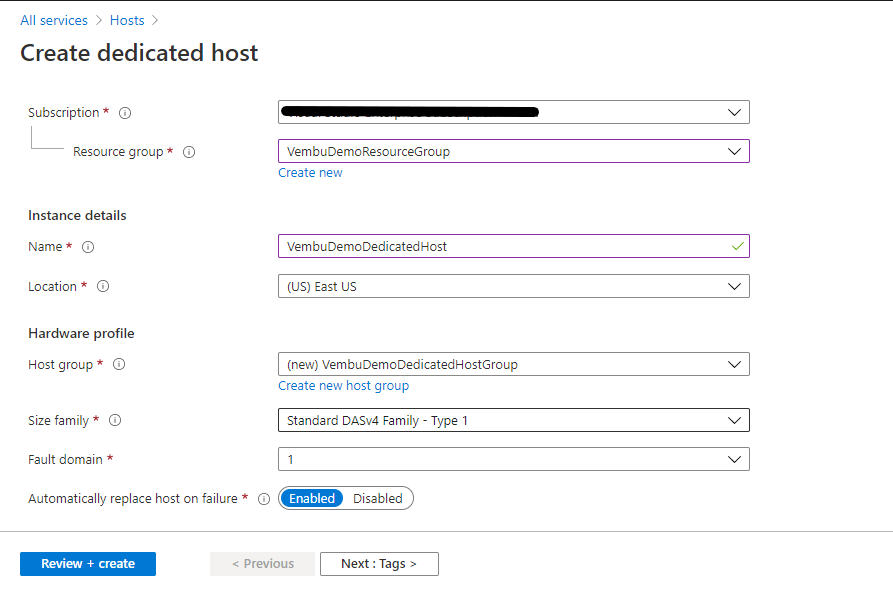
Size of family – Select the dedicated host VM family and hardware generation. You will only be able to provision VMs on this host in the same VM family. You can select any of the families from the drop-down list. By default, Standard DASv4 Family – Type 1 is selected. Click the Next: Tags button to proceed further.
Step 2 : Tags
Tags are name/value pairs that enable you to categorize resources and view consolidated billing by applying the same tag to multiple resources and resource groups. This is an optional step, and you can proceed to the next step Review + create a step.
Step 3: Review and Create step
In this final step, you may review the configuration you chose in the above steps, and a validation passed message shows your configuration details are valid.
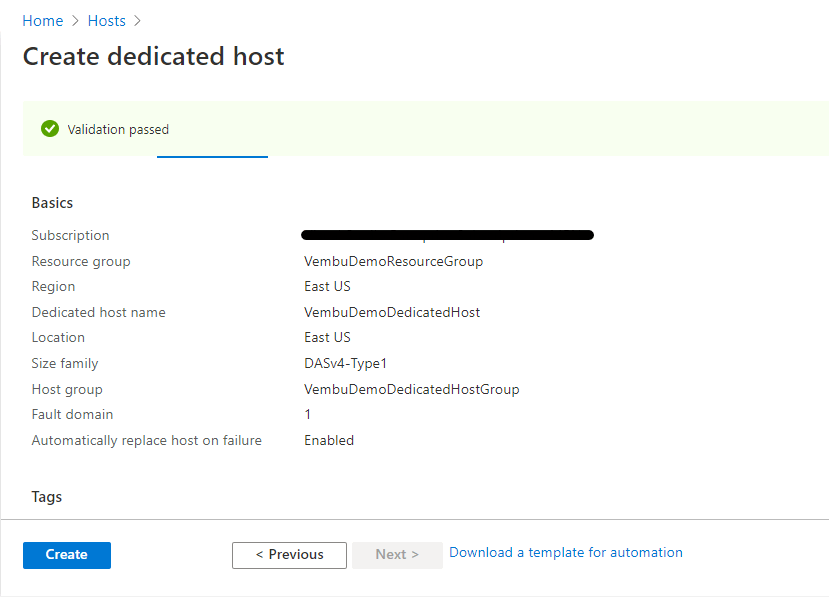
Click Create to finish creating a new Azure Dedicated Host on the EAST US region. You will get deployment in Progress for a while, and then your deployment will be completed as shown below.
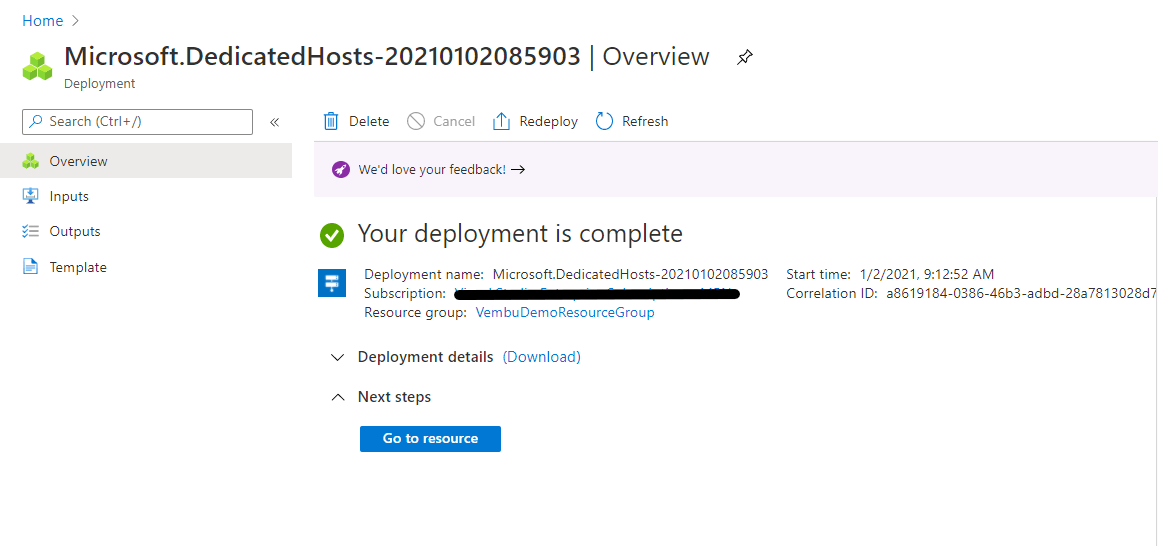
Click “Go to resource”, you will see all the details of your deployment on the dedicated host. You may find the available VM capacity, which shows the dedicated host supported VM family
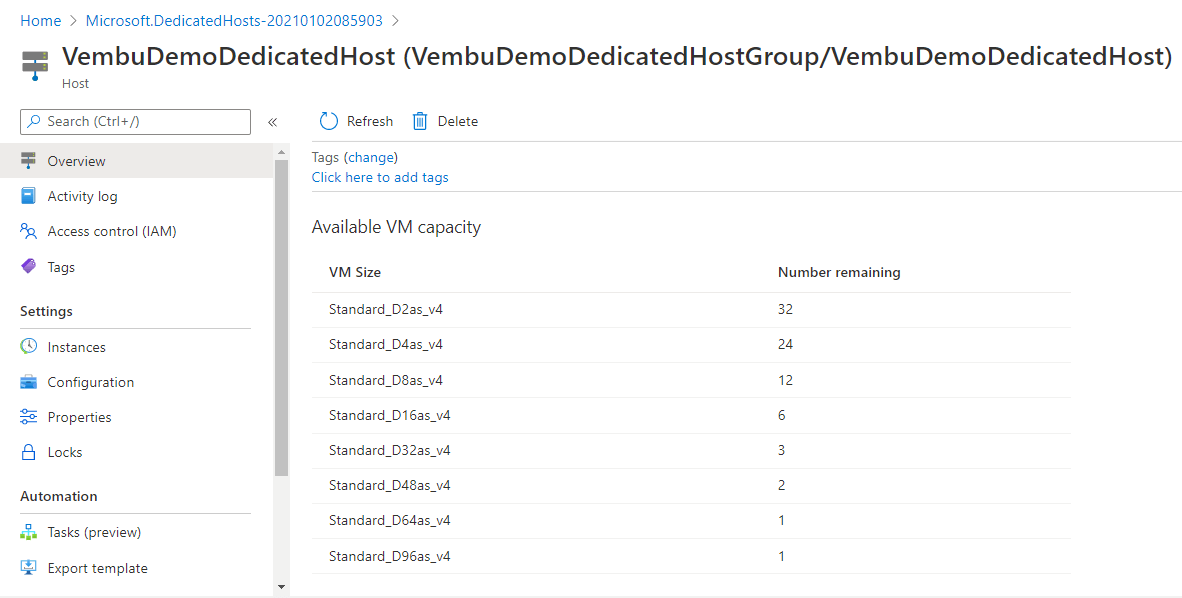
Capacity considerations while creating an Azure Dedicated host.
In most cases, while creating an azure dedicated host, check your Azure subscription has enough vCPU quota for the VM size family and Dedicated vCPU quota.
There are two types of quotas that are consumed when you deploy a dedicated host.
- Dedicated host vCPU quota. The default quota limit is 3000 vCPUs, per region.
- VM size family quota. For example, a Pay-as-you-go subscription may only have a quota of 10 vCPUs available for the DASv4 size series, in the East US region. To deploy a DASv4 dedicated host, you would need to request a quota increase to at least 96 vCPUs before you can deploy the dedicated host.
So, you may need to contact Azure support to raise your quota for both Dedicated host vCPU and the respective “Size family” you selected during the Basic step configuration phase.
During the initial configuration, you may end with the error as shown in the attachment below

The error message shows your quota for the Standard DASv4 family has only 20 vCPUs and requires at least 96 vCPUs. So you can increase the quota for Standard DASv4 Family. The below error message shows you require at least 96 Dedicated vCPUs also needed to host the said family Dedicated host. So you require to increase the Dedicated vCPU quota also.

Verifying your usage and permitted vCPU quota for your Subscription
Always you can verify your usage and permitted quota for your subscription before and after vCPU usage during the creation of any VM or dedicated host. In our case, we have created a quota increase request for Standard DASv4 Family vCPUs and Dedicated vCPUs separately. This can be verified under your subscription.
Choose your subscription Under General Categories → Subscriptions → Select the particular subscription → to choose usage + quotas under settings in left side menus. The below screenshot shows the details of Dedicated vCPU for the subscription.
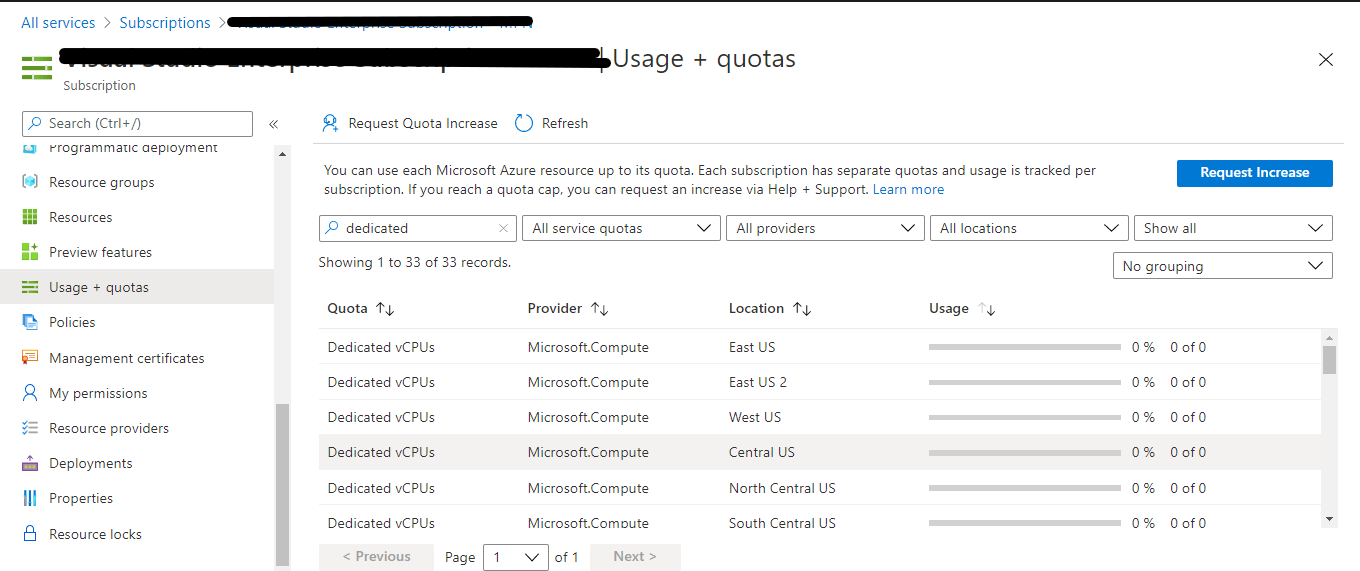
After quota raising, the below screenshot shows consumed and permitted quota details for the subscription.
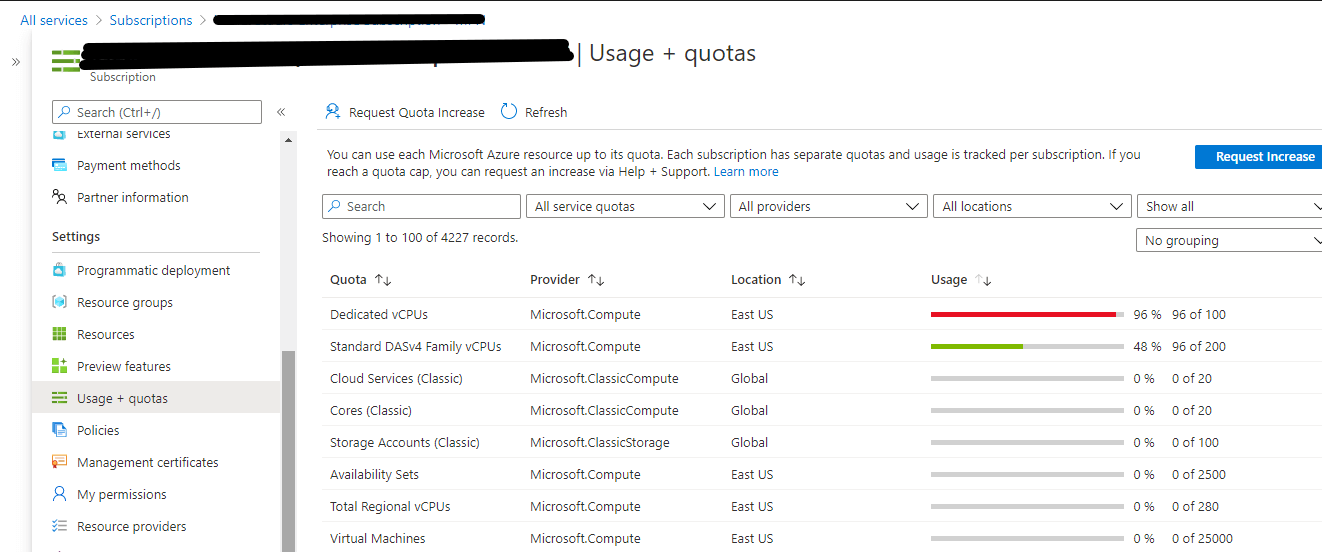
Creating a Virtual machine on the Dedicated host.
Just like creating an azure VM in an Azure cloud, you can follow similar steps for creating a VM on a Dedicated Host.
Select the particular Dedicated host → Under Settings chooses Instances → Click the Add VM button. Provide all the configuration details for Basic, Disk, Networking, and Management tabs. In the Advanced tab, choose Host group and Host details, which show your dedicated host and its host group. The below image shows an example of choosing the Host group and Host Details
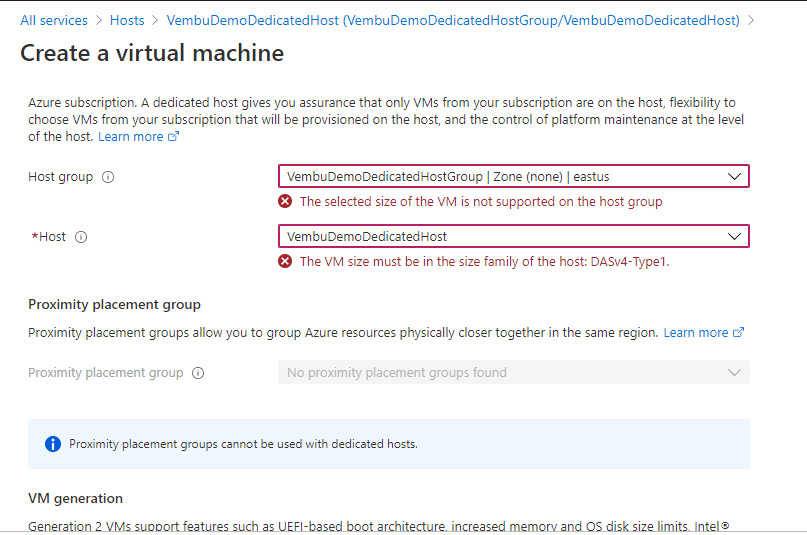
Adding an existing Azure VM to the Dedicated host
You can add an existing VM to a dedicated host, but the VM must first be Stop\Deallocated. Before you move a VM to a dedicated host, make sure that the VM configuration is supported:
- The VM size must be in the same size family as the dedicated host. For example, if your dedicated host is DSv3, then the VM size could be Standard_D4s_v3, but it could not be a Standard_A4_v2.
- The VM needs to be in the same region as the dedicated host.
- The VM can’t be part of a proximity placement group. Remove the VM from the proximity placement group before moving it to a dedicated host. For more information, see Move a VM out of a proximity placement group
- The VM can’t be in an availability set.
- If the VM is in an availability zone, it must be the same availability zone as the host group. The availability zone settings for the VM and the host group must match.
Deleting a dedicated Host
Before deleting the dedicated host, it is important to move your running VM to any dedicated host or move to Azure common host cloud. You can delete the dedicated host by pressing the Delete button, after selecting the particular dedicated host. You can also delete the dedicated host through API and CLI commands.

Click Yes, and your dedicated host will be deleted in few minutes
Conclusion
Azure Dedicated Host is a great service for small, medium, and enterprise companies that need to create a private environment, for security and compliance, or maybe when it requires using customized software for its employees. Even sometimes customers may require using Azure Hybrid environment along with Azure Dedicated Host deployments. Azure Dedicated host service has its advantages and disadvantages. Currently free and MSDN subscription does not support creating a dedicated host for your Organization. Similarly, your created VM resources on a dedicated host are bound to a certain level of supported family based on the dedicated host hardware family.
Related Posts:
What is Bare Metal Cloud? – Part 1
What is Bare Metal Cloud? – Part 2
What is Azure VMware Solution (AVS)
Microsoft Azure for Beginners: A Guide to Azure Cost Optimization – Part 12
Follow our Twitter and Facebook feeds for new releases, updates, insightful posts and more.



Leave A Comment